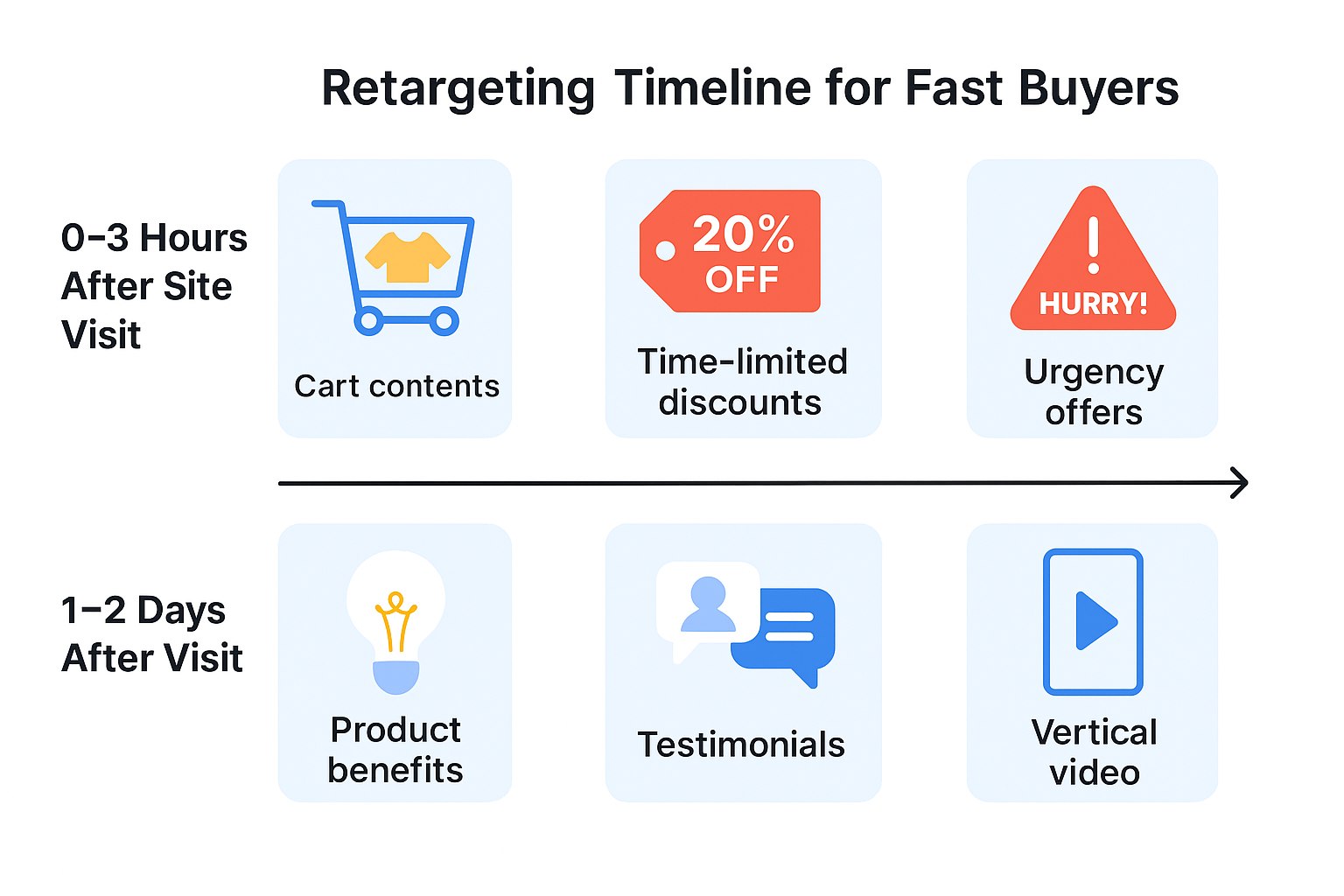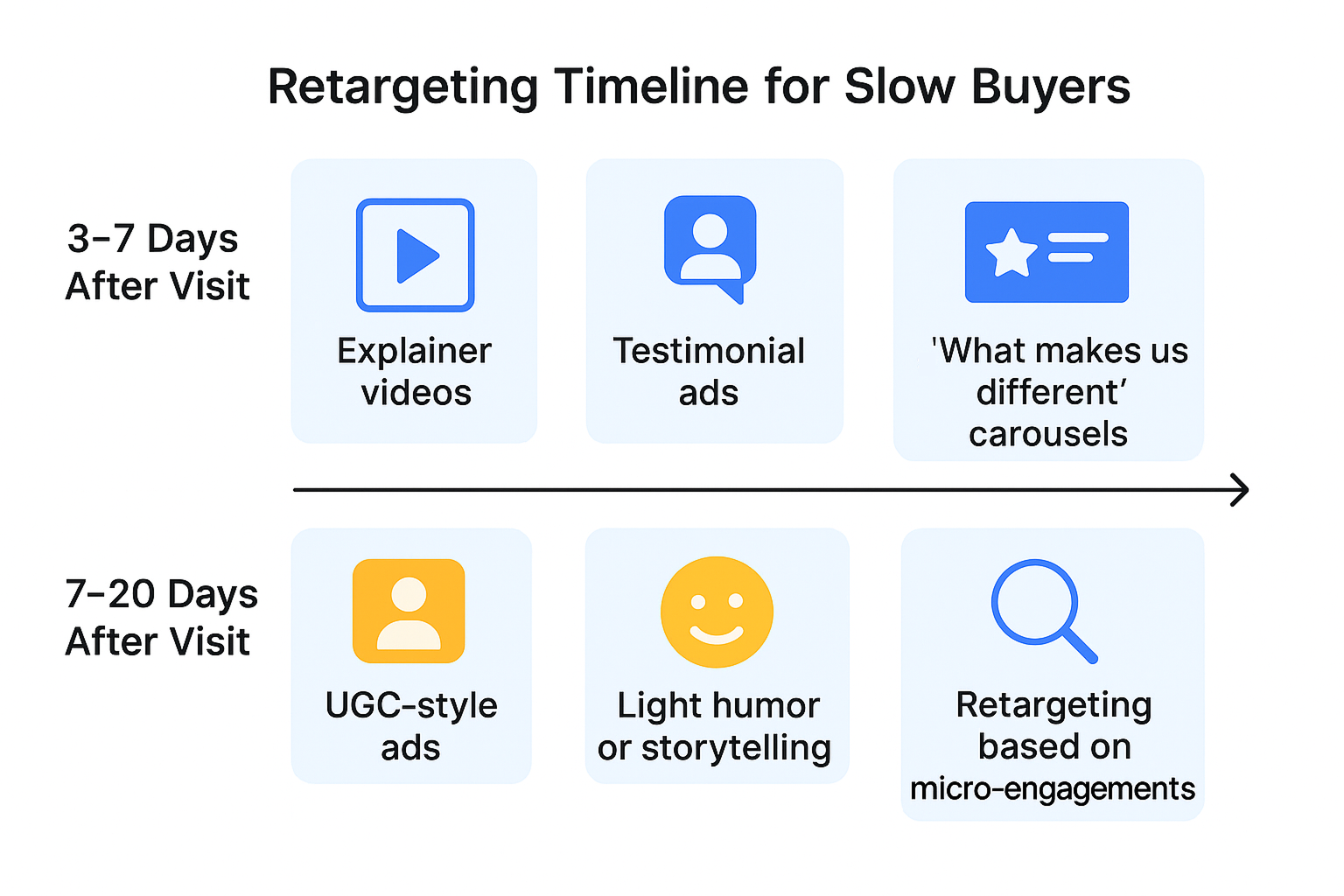When should you retarget someone after they visit your site?
Should you wait an hour? A day? A week? The answer depends entirely on one key factor: the speed of the buyer's decision-making process.
Some customers decide fast — maybe even after one visit. Others take their time, comparing, considering, and coming back later. If you treat both the same, you’re leaving money (and data) on the table.
Let’s walk through how to create tailored retargeting timelines for both fast and slow buyers — and how to stop wasting budget on bad timing.
Who Are Fast vs Slow Buyers?
To build a better retargeting strategy, you first need to understand who your audiences really are. Most site visitors fall into one of two categories.
Fast buyers are typically:
-
Acting on impulse or fulfilling an immediate need.
-
Familiar with your brand or product category.
-
Motivated by quick wins: discounts, convenience, or urgency-based messaging.
They don't need much convincing, just a nudge.
Slow buyers, in contrast, tend to be:
-
Cautious, price-sensitive, or unfamiliar with your offering.
-
Evaluating multiple competitors or researching.
-
Focused on trust, value, and long-term benefits rather than quick gratification.
You can’t treat these audiences the same way. Timing, message, and creative style all need to adapt. And to do that, you need to map their journey, understand intent signals, and sequence your retargeting appropriately.
Retargeting Timeline for Fast Buyers
When someone’s ready to buy, even a small delay can cost you the sale. Let’s explore how to capture fast buyers before their intent cools off.
⏱ 0–3 Hours After Site Visit
This is your most critical window. The moment someone bounces, they’re still in decision-making mode. Retargeting them during this period increases your chance of winning the sale dramatically.
Run ads that:
-
Remind them what they left behind, such as cart contents or specific product pages.
-
Offer instant incentives, like time-limited discounts, bonus items, or free shipping.
-
Build urgency, using phrases like “Only 3 left” or “Offer expires tonight.”
The creative here should be direct, action-focused, and visually consistent with your website. For example, dynamic product ads perform well because they reflect exactly what the user viewed.

📆 1–2 Days After Visit
If they didn’t convert in the first few hours, there’s still hope. Use this next phase to re-engage with helpful nudges.
Examples:
-
Showcase product benefits that eliminate doubts ("Why choose us" style).
-
Introduce reviews or testimonials from people like them.
-
Use vertical video or motion to stand out in feeds.
If your campaigns aren't converting in this window, your frequency or relevance could be off. Diagnose issues using Facebook Ads Not Converting: How To Fix It.
Retargeting Timeline for Slow Buyers
Patience is key. When someone’s on the fence, they don’t need pressure — they need clarity, trust, and value.

📆 3–7 Days After Visit
This phase is all about education. Your goal? To guide them closer to a decision.
Recommended ad types:
-
Explainer videos that show how the product solves their problem.
-
Testimonial ads that highlight real results from similar users.
-
"What makes us different" carousels comparing your offer with competitors.
You’re building confidence here, not urgency. This is a great time to layer in content that answers FAQs or handles common objections. Think of this as your "middle-of-funnel" retargeting.
Need help setting this up? Start with Facebook Ad Funnel Strategy to structure your approach.
📅 7–20 Days After Visit
This longer tail is often neglected — which is why it's such a big opportunity. Buyers who return after 10+ days are often more serious, not less. They just needed more time or exposure.
Here’s what to test:
-
UGC-style ads with authentic photos or video snippets.
-
Light humor or storytelling to keep your brand top of mind.
-
Retargeting based on micro-engagements (watching 75% of a video, clicking a CTA but not converting).
Want to go deeper into this segment? See Retargeting Leads Who Didn’t Submit for strategies that feel personal and non-invasive.
🚨 After 21+ Days
Many marketers turn off retargeting after three weeks. That’s a mistake. These users may have needed a payday, a decision from a team, or just less noise.
Tips:
-
Move them into a new retargeting tier with different creative.
-
Offer something new — a seasonal deal, a limited-time bonus, or a product bundle.
-
Try lead magnet retargeting instead of pushing a sale. Use downloadable content, trial access, or quizzes.
Smart Retargeting Tactics That Work for Both Buyer Types
No matter how fast or slow your customer is, these principles will help you increase your conversion efficiency:
1. Segment Your Audience Behaviorally
Don’t just use time-based rules. Look at actions taken on site:
-
How many pages did they view?
-
Did they scroll or bounce?
-
Did they view pricing?
Use these signals to create audiences with different levels of warmth. For a step-by-step guide, check Behavior-Based Facebook Targeting.
2. Mix Up Creative Styles
Even great creative fatigues fast. Rotate not just visuals, but format types:
-
Use Reels or Stories for fast, eye-catching motion.
-
Switch to carousels when you want to educate or compare.
-
Introduce text overlays to add clarity without relying on sound.
Need inspiration? The Best AI Text and Image Generators in 2024 can help you build variations faster.
3. Control Frequency Intelligently
Fast buyers can handle 3–5 impressions in 24 hours. Slow buyers? Stick to 1–2 impressions every few days.
If you’re seeing click-throughs drop as impressions rise, it’s time to rotate. Learn more in How Frequency Capping Helps Beat Facebook Ad Fatigue.
4. Align Your Objective With Buyer Intent
Don't optimize for conversions if your audience is still cold or undecided. Start with video views, engagement, or lead objectives. Then warm them up before retargeting for a sale.
To choose the right objective for your campaign phase, read Meta Ad Campaign Objectives Explained.
Final Thought: Good Retargeting is Intent-Aware
Retargeting that doesn’t consider buying behavior is like emailing your entire list the same message, every day, for two weeks. It might get clicks, but it will also get unsubscribes, blocks, and budget waste.
Instead, pay attention to your data. Start segmenting your campaigns based on:
-
Visit recency,
-
Site depth of engagement,
-
Funnel stage.
Then craft ad experiences that reflect where people actually are in their journey. That’s how you win trust — and revenue.

